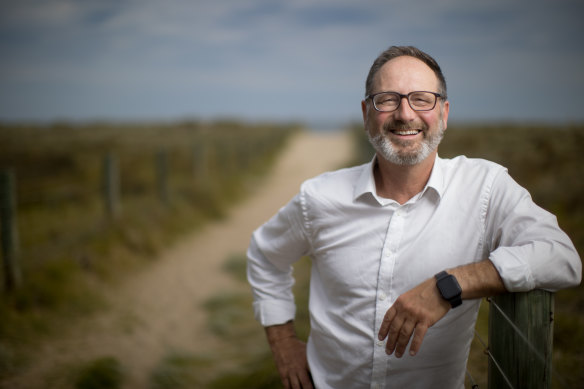It’s dizzying to watch Faith Dickey crouching on the highline above the Colorado river 300 metres below. Then the 32-year-old stands, wobbling slightly, cool as a cucumber and proceeds to walk the line.
In the voice-over for the clip – part of the surprisingly good new show, Limitless with Chris Hemsworth – Dickey explains that thinking about walking the whole line across the canyon would be so overwhelming she would be paralysed.
When we feel overwhelmed, segmenting a task can help us to regain control and clarity.Credit:Getty
Instead, the multiple world record holder manages her fears and the stress of what is ahead of her using a technique she refers to as segmentation, where the task is broken into small chunks. For her, that chunk is a single step: “I don’t think about the full walk [across a void]; I focus on one step. One foot in front of the other. That one step can propel me all the way across.”
It’s a tool that can help us all right now.
Over the past few years, we have experienced “cascade of stresses,” including COVID and its financial, emotional and physical health knock-on effects, extreme weather events, climate change, and cost of living pressures, says Dr Grant Blashki, the Lead Clinical Advisor for Beyond Blue.
There has been barely any time to process it all. Instead, we’ve gone back to the office and to the frenetic pace of “life as normal”. And, instead of stopping when we need to, many of us caffeinate more, pop some paracetamol when we’re sick and plow on.
GP and Beyond Blue lead clinical adviser Grant Blashki.Credit:Simon Schluter
“And now we’ve got the mixed, mixed blessing of Christmas time – it’s nice to be with family, but also creates a lot of stress,” says Blashki. “Underlying that is really I think a culture where our cognitive bandwidth is stretched more than ever.”
And why wouldn’t it be? On top of the events of recent years, we jam every spare moment with screen time.
“The interstitial space of life has been filled by technology,” Blashki says. “But, our minds weren’t designed to be on all the time. When people don’t get that space, they end up with a chronic sense of pressure, of anxiety… and they find they can’t switch off.
“So they, they feel exhausted, but they can’t switch off… that chronic distractedness is not great for relationships either.”
WHO data from earlier this year found anxiety and depression increased 25 per cent around the world; separate research published in September suggests more people are experiencing burnout around the world; a Beyond Blue survey from August found cost of living pressures and lurching from one challenge to another is having a deleterious effect on people’s mental wellbeing; and our kids are feeling it too, according to new APS data which found a 36 per cent increase in separation anxiety.
This brings us back to Faith Dickey crouched on the highwire with a seemingly insurmountable task ahead of her. At a time when many people are feeling frayed, burnt out or overwhelmed, segmentation – or chunking, as it is otherwise known – can make a measurable difference to how we feel.
“Step one is being kind to yourself,” says Blashki, who tells patients who are highly stressed to return to organic time rather than mechanical time. “What I mean by that organic time is the rate of a tree growing or the ocean tide moving up and down. It’s slow, it’s cyclical and mechanical time is, that really fast flicking of our phones or digital world that we’re living.”
He adds that step two is getting clear on our goals. “Work out what is actually important to you. I don’t just mean work goals. I mean think more broadly about your personal goals of health, of happy relationships and spending time with people you love.”
Then, according to those goals, chunk your time and your tasks.
“People have this restless sense that every moment ought to be filled for me. But I often say to my students that splashing is not swimming. And what I mean by that is activity doesn’t mean you are more productive,” he says. “You don’t need to be going all the time. No one can do everything. But once you work out what the really important things are for you then OK, focus on that.”
Dr Jodie Lowinger’s psychology career has exceeded her expectations.
Segmenting a task allows us to focus on what is in our control, says Dr Jodie Lowinger, founder of The Anxiety Clinic.
She says: “If we are purely focused on our end goals we can be focused on an uncertain future focused outcome and uncertainty is a fundamental trigger of worry (to try to get certainty when there is no certainty), which leads to hypervigilance to threat, our inherent negativity bias, stress and anxiety (our physiological reaction to perceived threat ie uncertainty).”
Segmenting can be done in a variety of ways.
If you have a goal like starting exercise, for instance, segmenting might mean placing your workout gear next to your bed; then putting on your trainers; and walking to the mailbox and back. The next segment might be walking to the corner of your block, then around the block.
Segmenting for anxiety could involve small steps out of your comfort zone, Lowinger says. “These are all chunking exercises and a powerful way to live the life that you want to live not what worry is telling you.”
She frequently uses these techniques, she says, and breaks down a ten or five-year mission into segments: annual goals, quarterly priorities, weekly goals and daily tasks. Based on that segmented larger goal she can then focus on the next immediate priority.
Although for more severe problems or when an issue isn’t improving, people might need help from a psychologist, segmenting has a “broad range of uses”, everything from preventing mental health problems to managing stress, anxiety or depression, adds Blashki.
And when we stop and focus on what is in front of us, what is in our control, we can take life one step at a time and start to see more clearly, something we can’t do when we are overwhelmed and life feels foggy, he says: “The world unnoticed is lost on you.”
Support is available from Beyond Blue on 1300 22 4636 and Lifeline on 13 11 14.
Make the most of your health, relationships, fitness and nutrition with our Live Well newsletter. Get it in your inbox every Monday.
Most Viewed in Lifestyle
From our partners
Source: Read Full Article



